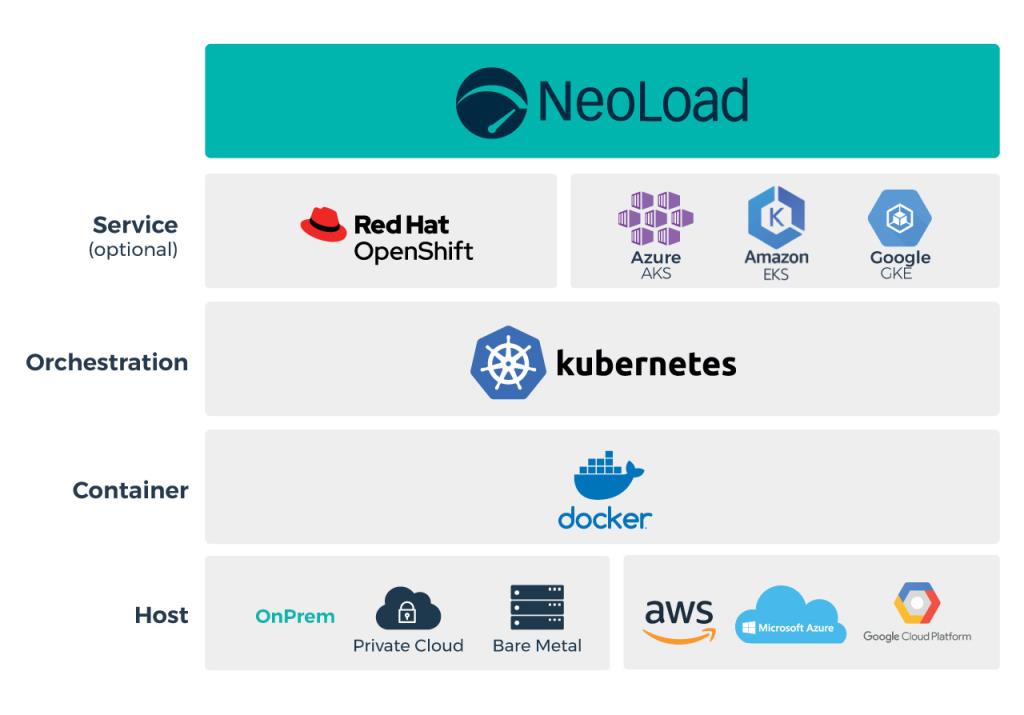Dynamic Infrastructure
Dynamic Infrastructure allows provisioning your load-generating infrastructure (Controller and Load generators) as needed on any infrastructure managed by Kubernetes, OpenShift or managed by Kubernetes services (AKS, EKS, GKE).

Thanks to one of these orchestrators, the required load infrastructure is up and running for the duration of your tests only at the appropriate scale.
This facilitates both declarative configuration and maintenance of your load infrastructure while optimizing sizing and usage on demand.
Why do you need NeoLoad Web to make the most of your Dynamic Infrastructure?
Not only does NeoLoad Web abstract and simplify access to the Kubernetes and OpenShift layer, but the NeoLoad Web APIs provide a simple and unified way of running performance tests.
Both container experts and newcomers can rely on NeoLoad Web to dynamically manage their load testing infrastructures with pre-configured or custom container images and hardware specifications.
It doesn’t matter if your organization chooses a self-managed orchestrator or a cloud vendor-managed service because NeoLoad Web will natively leverage both of these.
While some performance testing solutions may impose restrictions on providers or services, NeoLoad Web remains widely open.
CI/CD performance tests can also greatly benefit from Dynamic Infrastructure: you can easily run performance-test pipeline tasks into dynamic zones, each time provisioning a temporary load generating infrastructure for only the duration of the test.
What’s the value of Dynamic Infrastructure?
-
Reduce Total Cost of Ownership (TCO) on testing infrastructure costs.
Infrastructure remains one of the biggest expenses of testing. Avoid tying up machines for tests all day when they could be used for other purposes. Scaling your infrastructure is now a less cost operation. Don’t oversize it in prediction of activity variations.
-
Focus on your business activities.
Save time on provisioning, starting, stopping machines on demand or per period. Stop developing your own provisioning scripts. Scale load generators in one click.
-
Leverage existing containerized platforms.
Teams skilled in working with self-managed orchestrators can use their on-premise, private cloud or bare metal deployments. For customers who use managed cloud orchestrators from Amazon, Google, Microsoft or other providers to manage their containers, NeoLoad Web also connects natively to EKS, GKE, AKS to manage load testing infrastructure dynamically.
Supported Kubernetes
Mainly all kinds of Kubernetes deployment are supported:
-
AKS (Azure Kubernetes Service) is the managed Kubernetes cluster offer from Microsoft Azure.
-
EKS (Elastic Kubernetes Service) is the managed Kubernetes cluster offer from Amazon Web Services.
-
EKS can be used in combination with EC2 and/or Fargate. EC2 based clusters will be required to manage static nodes whereas Fargate is able to build a cluster on top of fully dynamic resources.
-
GKE (Google Kubernetes Engine) is the managed Kubernetes cluster offer from Google Cloud.
-
RedHat OpenShift Container Platform. OpenShift is a Kubernetes distribution built by RedHat. It is proposed as a self-hosted or RedHat hosted cluster.
In this section
Check out the following topics on dynamic infrastructure: